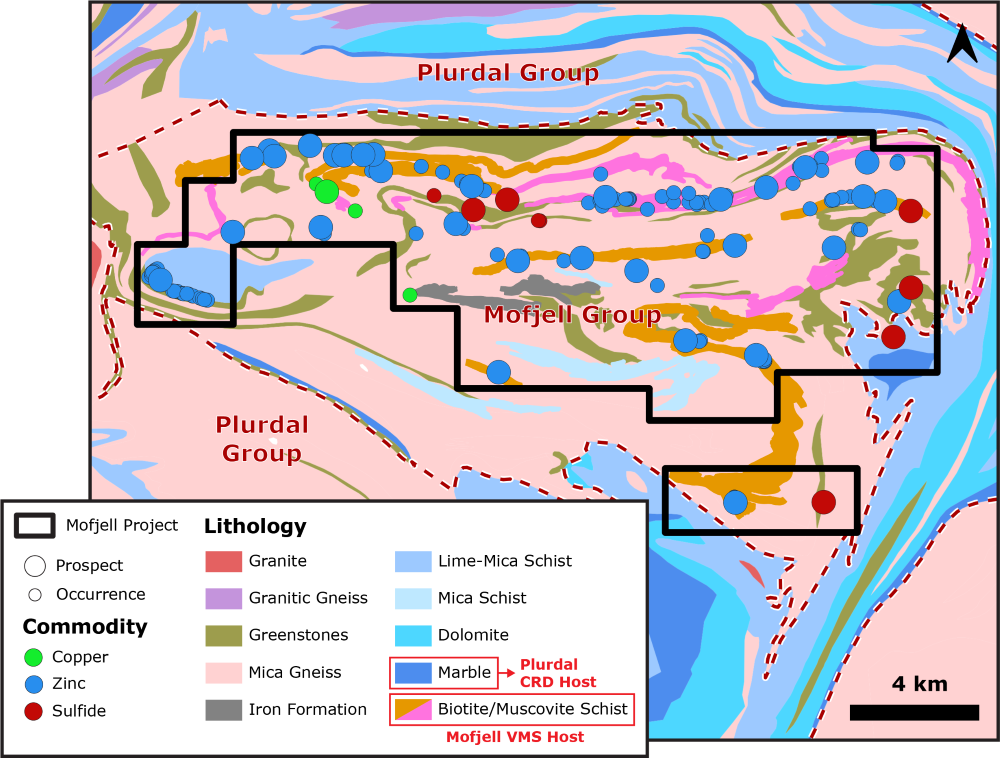Mofjell
The Mo-i-Rana belt is part of a broad initiative that EMX is executing in Norway, where it has been steadily acquiring and forming partnerships to advance a variety of projects, including polymetallic base metal deposits, orogenic style gold systems and “battery metal” (nickel-copper-cobalt-PGE) type deposits.
VMS style polymetallic deposits are developed in the Rana-Hemmes metallogenic region of Norway, which is also host to the prolific Rana Gruber iron mines as well as the nearby Bleikvassli Zn-Pb-Cu-Ag deposit, an EMX royalty property being advanced by Norra Metals Corp (TSX-V:NORA). This metallogenic area represents a tectonically displaced continuation of the Cambrian-Ordovician metallogenic belts in northeastern North America, which includes the Buchans and Bathurst VMS camps in eastern Canada, and also the Avoca VMS district in Ireland. As such, this represents one of the more prolific VMS belts in the world in terms of total production from its various mining districts, albeit now tectonically dissected and occurring along opposite sides of the Atlantic Ocean.
VMS, Carbonate Replacement Deposit (“CRD”) and skarn types of mineralization are seen in the Mo-i-Rana district. Deposits are hosted by a deformed 10 x 25 kilometer belt of bimodal felsic and mafic volcanic rocks and sediments. This belt of volcanic and sedimentary rocks includes the Mofjell Group and Plurdal Group, which host a variety of pyritic base metal deposits with variable, but poorly documented enrichments in precious metals. At least nine individual VMS horizons are known to exist at different structural/stratigraphic levels in the Mofjell group and were intensely deformed (post-mineralization) during the Caledonian orogeny (490-390 million years ago). Some of these zones are quite extensive and can be traced along trend for up to up to 20 kilometers (Ibid1).
The most notable deposit, the Mofjell Mine, (the core of which remains covered by state-owned mining licenses) operated for over 50 years, closing in 1987. The deposit consists of three rod-shaped elongate VMS lenses, approximately 100 meters wide that extend for lengths of up to 2.8 kilometers. Just prior to mine closure, high gold and silver grades were discovered as disseminations in wall rocks within the historical mine workings (such as 2.8 meters averaging 3.88 g/t Au and 44.3 g/t Ag in underground drill hole DD1313 and 3.7 meters averaging 2.30 g/t Au and 75.7 g/t Ag in underground drill hole DD781A; true widths unknown) but were never followed up. This underscores the potential for additional discoveries of precious-metal enriched zones of mineralization in the belt.
On February 14, 2022 EMX executed an agreement to sell its Mofjell volcanogenic massive sulfide project (previously Mo-i-Rana) in Norway to Mahvie Minerals AB (“Mahvie”), a private Swedish Company (see EMX news release dated February 17 2022). In return for the transfer of the Project to Mahvie, the agreement provides EMX with a 9.9% equity interest in Mahvie, annual advance royalty payments, 2.5% Net Smelter Return (“NSR”) royalty interests, work commitments, and other considerations.
In 2008, a partnership between industry, the Norwegian Geological Survey (NGU) and the local county administration was formed to investigate additional potential in the Mo-i-Rana belt. This effort generated high resolution airborne geophysical data sets, as well as district scale mapping and geochemical sampling campaigns carried out by the NGU. These represent key data sets that EMX and Mahvie intend to utilize for further advancement of the Project.
*Nearby mines and deposits provide context for the project, but do not necessarily indicate similar size, styles or grade of mineralization within the project.
Maps
Photos

 Click to Enlarge
Click to Enlarge